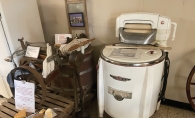Robotics is a way students can learn and apply valuable science, technology and engineering skills. Osseo area schools offer a variety of opportunities for students at varying ages to participate in robotics programming. At the high school level, robotics is known as a varsity sport for the mind and is a Minnesota State High School League sanctioned activity.
Maple Grove and Osseo Senior High Schools each host engineering clubs for interested students to build and program robots. Wayne Hamilton was a technology education teacher and engineering club advisor at Maple Grove Senior High School until his retirement in June, and he was heavily involved with the program. The club is known as Crimson Robotics.
Hamilton says Crimson Robotics was created to promote engineering and STEM coursework at the school. This after school club involves approximately 40 high school students who are actively involved in club meetings and robot construction. The club receives some funding support from Boston Scientific and has participated in robotics competitions since it’s founding in 2008.
“Competitions are a fun way for students to get to work with industrial grade sensors, motors, micro-controllers and also learn programming,” says Hamilton. “Competition also provides a great opportunity for students to learn teamwork.”
Crimson Robotics members compete annually in the First Robotics Competition (FRC). First is a non-profit organization founded in 1989 to inspire young people's interest and participation in science and technology. FRC is said to combine the excitement of sport with the rigors of science and technology. Under strict rules, limited resources, and time constraints, teams are challenged to raise funds, design a team brand, hone teamwork skills, and build and program a robot to perform prescribed tasks against a field of competitors. It’s said to be as close to real-world engineering as a student can get. Previous competitions have required robots to perform activities such as shooting baskets, tossing rings, navigating obstacles or passing, placing and stacking objects.
2008 Maple Grove Senior High School graduate Philip Kirshbaum recalls the club’s very first team competition. “It was a big deal. A four day event in Milwaukee, Wisconsin with 60 teams participating from various high schools,” Kirshbaum says. “We essentially had to program our robot to play a game. We were inexperienced and the programming was pretty tough.”
Krishbaum and his teammates had to tune up their robot after each match. He notes with a chuckle that things don’t always go according to plan. But when his team was struggling with their robot, a student from a Wayzata robotics team stopped by and offered tips on jump-starting their source code. “His assistance went a long way to helping our robot function the way we envisioned,” Kirshbaum says.
This experience of friendly advice from an adversary is not uncommon in robotics competition. Hamilton says FRC competitions have an element of excitement much like a sporting event. “But the FRC has a philosophy of cooperation,” says Hamilton. “In other words, it’s not so much about the competition as it is about how much students can help each other out.” Teams help other teams. Veterans help rookies. Kids learn skills from each other like programing and working with vision processing from a digital camera.”
2013 Maple Grove High School graduate, Nathan Grotz was active with Crimson Robotics for three years. He says that not only did the club help grow his knowledge of design; it was neat to be with others who share similar interests. “We worked together toward a common goal,” says Grotz. “It was cool to go to competitions and see the culmination of all our hard work.”
Maple Grove High School physics teacher and engineering club co-advisor, Erik Malm says the rules for robot construction and the game objective for each year’s First competition are released in January. All participating teams receive an identical kit of starter parts. Teams are allowed to make or order any additional parts as long as they stay within the financial and technical limits of the rules. “We then have six weeks from that time to build an entire robot from scratch,” says Malm. According to Malm, adults on the team do not assist in robot design beyond brainstorming and guiding students in the appropriate direction. “Although our goal is to perform well at competition,” Malm says, “we believe it’s more important to prepare students with the skills necessary to help them be successful science and engineering students.”
Many of the club members plan to pursue careers in science or engineering. Others participate just for fun or for the challenge. The team is broken down into groups: mechanical, electrical, pneumatic, programming and tech challenge. “The club isn’t all about engineering,” says Grotz. “Some students get involved in the business side of things or website design. Students get to choose which group they want to be in as well as their level of participation.”
Grotz plans to attend Mankato State University this fall to study automotive engineering. He says the hands-on problem solving he practiced with Crimson Robotics should aid his college career. Kirshbaum went on to receive a college degree in aerospace engineering and now works as a software engineer designing flight simulators. He says his high school engineering club’s emphasis on teamwork was the best take-away for him. “No one individual can build that robot in six weeks,” says Kirshbaum. “Learning to achieve a goal through cooperation goes a long way in life.”//









